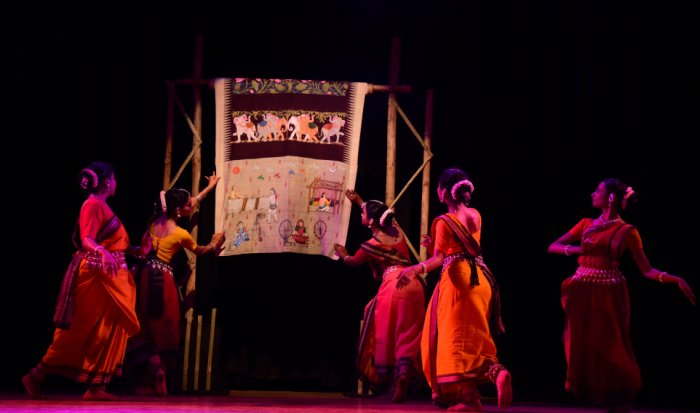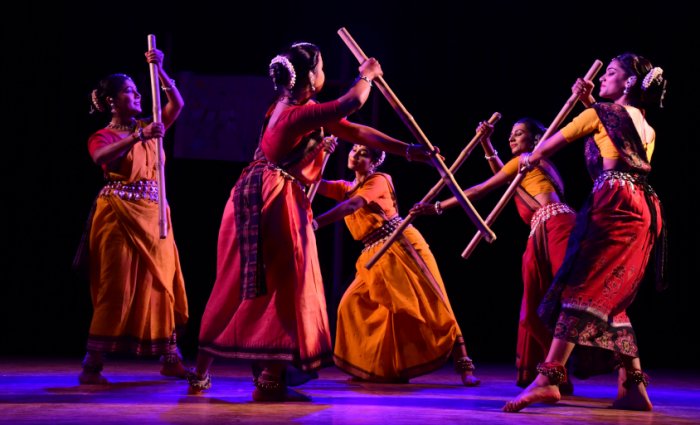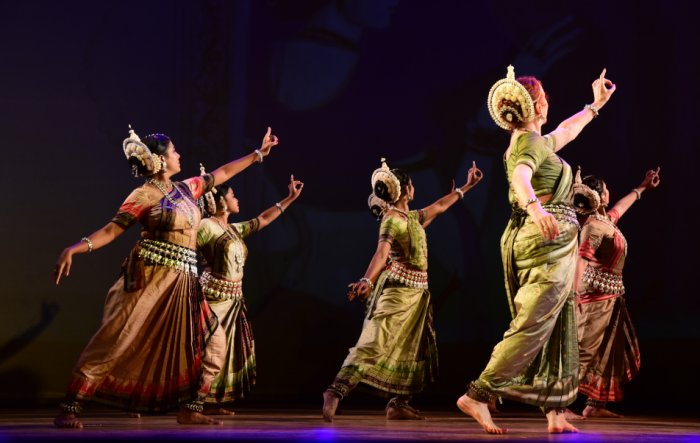
|   |

|   |
 e-mail: leelakaverivenkat@gmail.com Life's dreams spun into weaver's thread December 3, 2022 At the Habitat Centre, Ileana Citaristi, in a recital featuring her with students of her institution Art Vision founded in 1996 in the old city of Bhubaneswar, presented her own choreographies. Underlining the problems in arranging out-station programmes with no sponsorship, was the appallingly thin audience. Beyond providing auditorium space, Habitat was not directly involved with the event in any way, and with another programme of dance being held in the same building downstairs, the non-local group was at a distinct disadvantage. Starting with an invocation to river Ganga based on Shankaracharya's Ganga Stotram strung to Rohan Dasgupta's music, dancers in squatting position as if in water, paid homage to the river adorning Shiva's head . Rushing with restless energy to meet the Ocean, like a nayika her beloved, are the Ganga's pearl like waves which wash away sins, earning salvation for the worshipper. For the devotee, being a turtle or a fish in its waters is a greater boon than being a wealthy king.   Suta Based on Devdas Chotray's Oriya ode to the weaver's creativity, the production Suta likened the story of the thread, strung to the loom, to the metaphor of life itself. Like the lines on man's palm, some straight, some curved, the vicissitudes of life, with prosperity at times and downward trends at others, are compared with the tana-bana, warp and weft of the weaver's thread. For the weaver, life's dreams and fears are interlocked with the threads in the cloth, woven of different colours. And what he creates ultimately with the fishes and deer horns and rangoli like border patterns on the anchal, reflect the weave of his life itself, with its myriad colours. When the colours of youth fade away and life's thread begins to wear out and finally snap, the weaver wishes that his body, on its final journey, be wrapped in the bright hues of newly woven cloth. Reflective of the highs and lows of varied phases one goes through in life, one appreciated, more than the movement imagery, the creative imagination, prompting the effort to wed the Odissi dance idiom to such a theme. Also imaginative was the electronic music composed by Annada Prasanna Patnaik, the khatar/patar of the music of the moving looms proving the most evocative accompaniment to bring alive the imagery expressed by the poet. Alongside the dance, the visual imagery of simultaneous screening of slides of woven sarees, could not be availed of on this stage, thereby robbing the presentation of some effect. The Pallavi in raga Belaboli (one hears it is a typical Odissi raga) composed by singer Laxmikant Palit in ektali, with the rhythmic passages composed and set by percussionist Satchidananda Das, in a group presentation had a certain fluid flow in movements, from slow to drut tempo at the end, as choreographed by Ileana. Instead of yet another nondescript translation of music into rhythm and movement, a Pallavi dance composition based on one central movement motif (much as Ileana's Guru Kelucharan used to do) around which the dance is structured, would make for a distinct impression of a movement pattern associated with the particular item. Thus in the guru's case the Arabhi Pallavi as distinct from the Shankarabharanam, came from the movement imagery. (whether of Puri Jagannath image in bahuda jatra or torso movements, etc).  Meghadootam The last item based on Kalidasa's Meghadootam with the Yaksha requesting the cloud to act as a messenger to convey his message of love to his beloved, with Ileana herself in the main role, takes a largely descriptive role of Nature in all her glory - entreating the cloud not to get distracted by the scenes and call of birds on the way to the Himalayan abode of Shiva with the drums at dusk announcing the evening prayer (this being the time when lovers have their secret trysts), the Yaksha wants the cloud to unobtrusively seek out his beloved, beautiful beyond compare, and pass on his message of love to her. As part of a programme, along with another major narrative like Suta, Meghadootam became an overdose of another production spinning out into many scenes. Without collaborative assistance, undertaking out-of-city programmes involving travel, stay and performance for a group, is risking too much for too little gains.  Writing on the dance scene for the last forty years, Leela Venkataraman's incisive comments on performances of all dance forms, participation in dance discussions both in India and abroad, and as a regular contributor to Hindu Friday Review, journals like Sruti and Nartanam, makes her voice respected for its balanced critiquing. She is the author of several books like Indian Classical dance: Tradition in Transition, Classical Dance in India and Indian Classical dance: The Renaissance and Beyond. Response * I am glad that such an effort is being applauded by an ace dance critic. It is indeed difficult for artists who are basically freelancers to arrange out of station shows completely on their own without any sponsors. It is in a way asking an artist to think more about business than his/her artforms. The illustrious art and cultural institutions of the country started out as a supportive umbrella for the propagation of art and artists. But now it seems that artists are left to fend on their own. It is a grave concern when newer forms of artistic expressions are not given exposure and platform to flourish. The youth of this country need to see and receive the encouragement of the cultural institutions to pursue classical art, which will eventually bring in more serious performers and doers in this field. - (Dec 4, 2022) Post your comments Pl provide your name and email id along with your comment. All appropriate comments posted with name and email id in the blog will also be featured in the site. |